Abstract
We tested urine samples from patients at different stages of current leptospirosis and thereafter to determine whether use of the PCR for detection of leptospires in urine can be a valuable alternative to culturing. The procedure of DNA extraction and subsequent PCR applied to 15 freshly voided urine samples proved to be twice as sensitive as culturing. Overall, we were able to detect leptospires in approximately 90% (26 of 29) of the urine samples. Urine and serum samples were obtained from seven patients, before the eighth day of illness. Although it is generally assumed that leptospiruria starts approximately in the second week of illness, we were able to detect leptospires in all of these early urine samples. In contrast, only two of seven corresponding serum samples gave positive PCR results, which suggests that PCR analysis of urine can be more successful for early diagnosis of leptospirosis than PCR analysis of serum. Urine samples from six patients who had been treated with antibiotics at the time of illness were positive by PCR, implying that the patients were still shedding leptospires in their urine despite treatment. Some of these samples were even taken years after the infection, indicating that shedding of leptospires in urine may last much longer than is generally assumed. We conclude that detection of leptospires in urine with PCR is a promising approach for early diagnosis of leptospirosis and may also be useful in studying long-term shedding.
Full text
PDF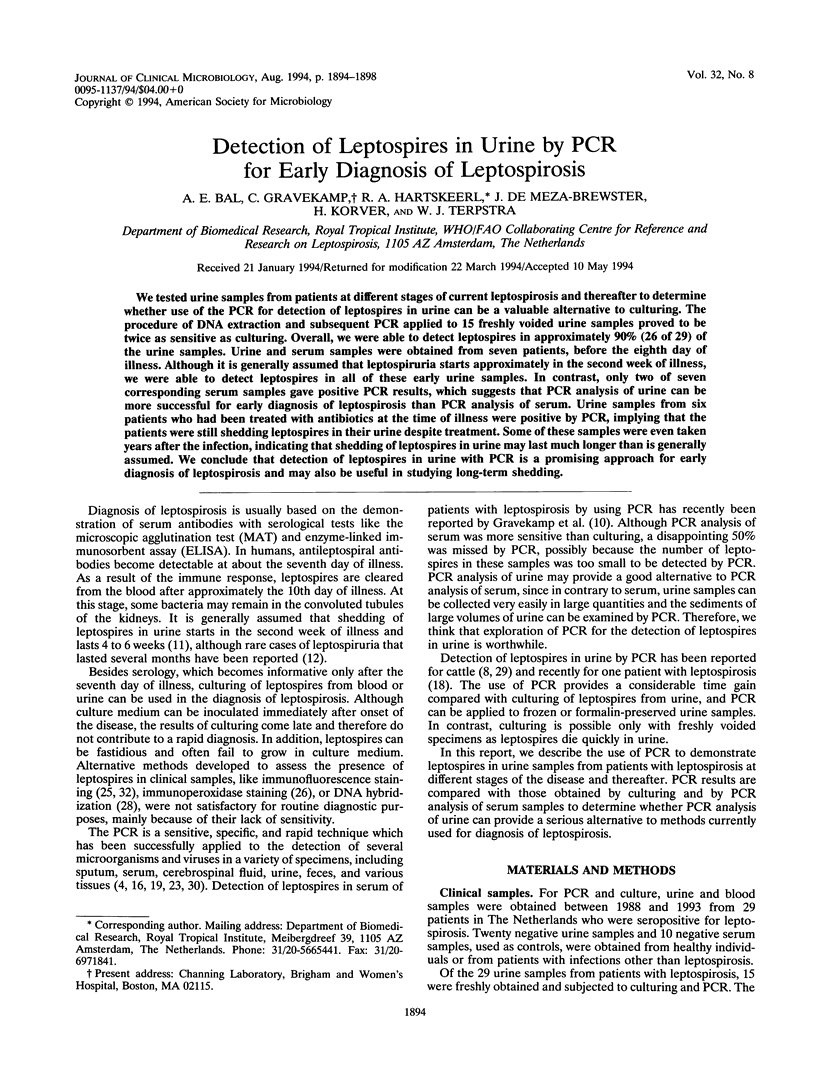
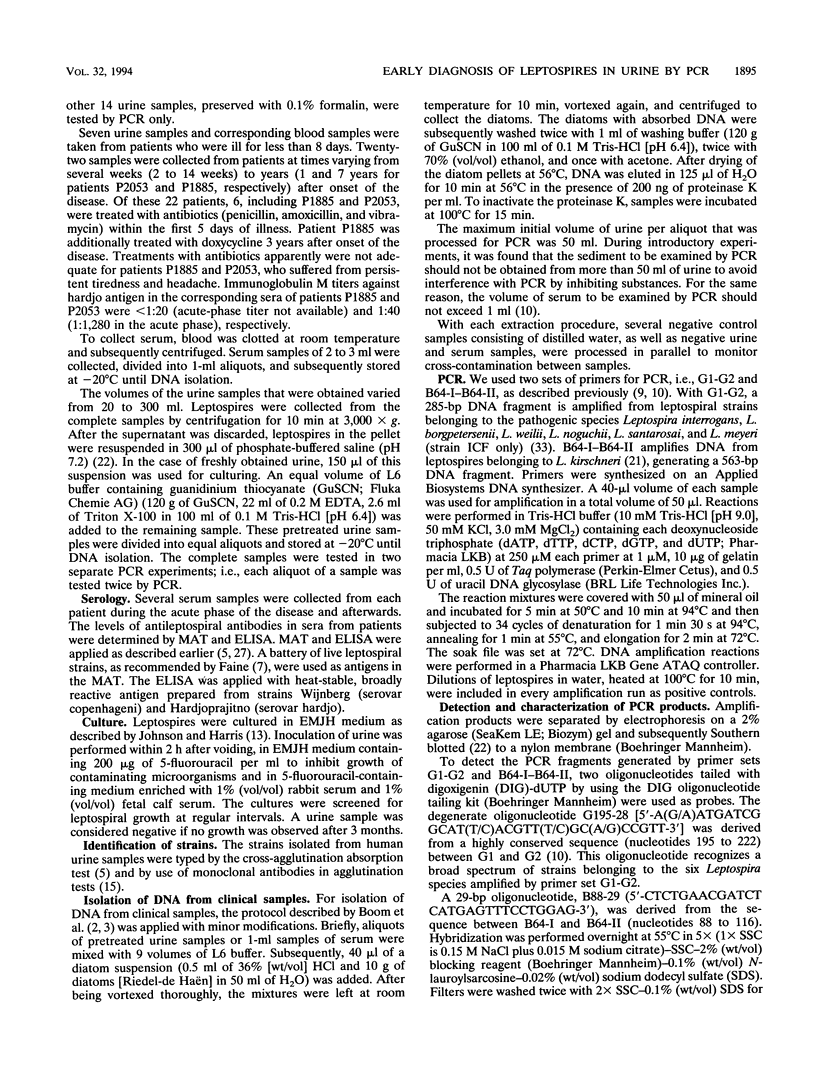
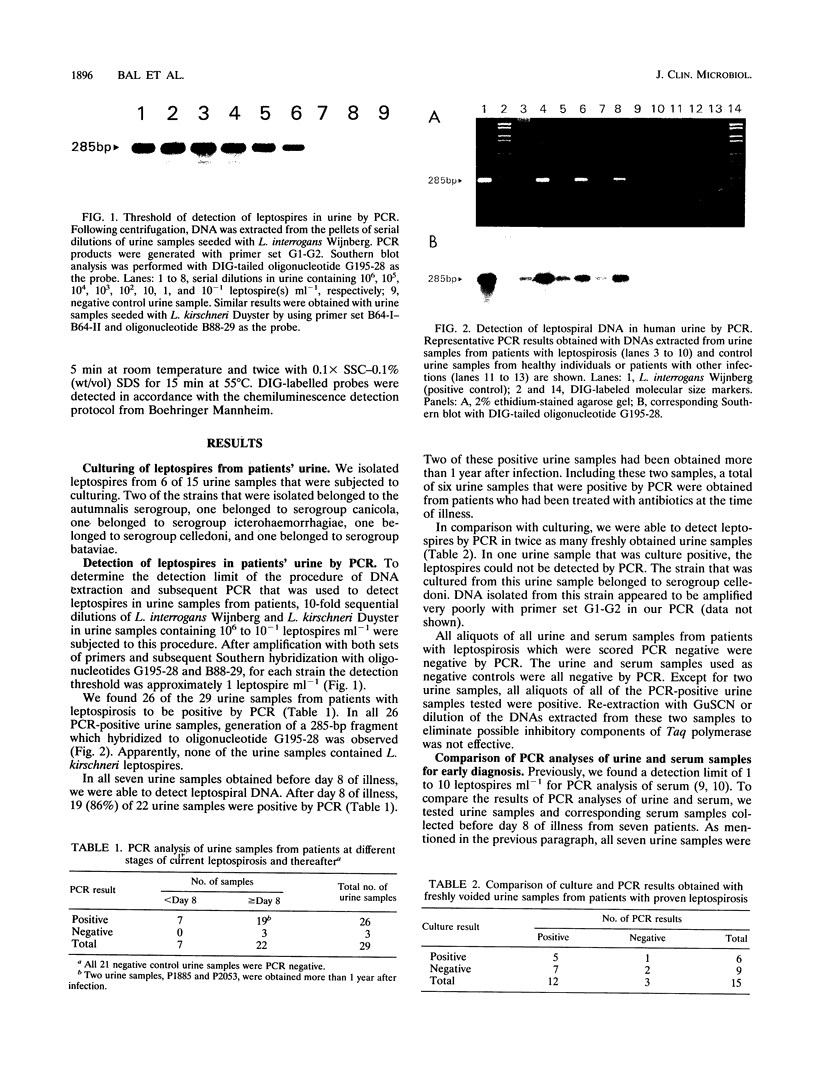
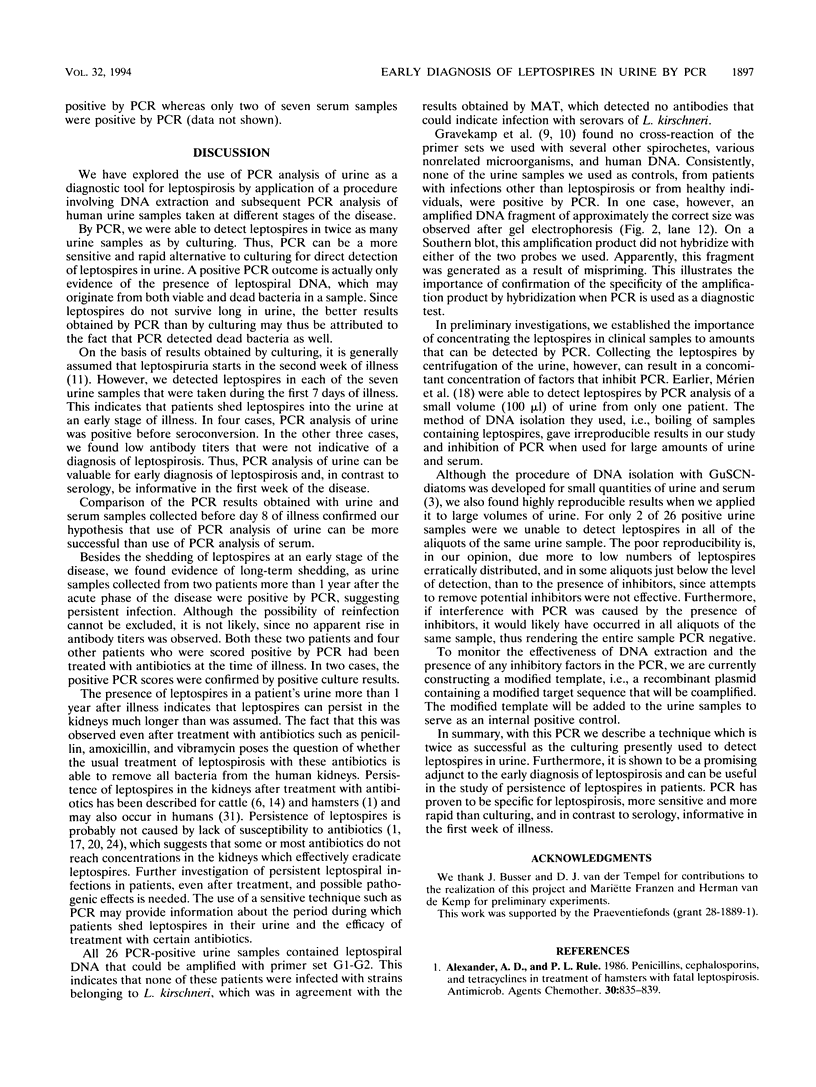
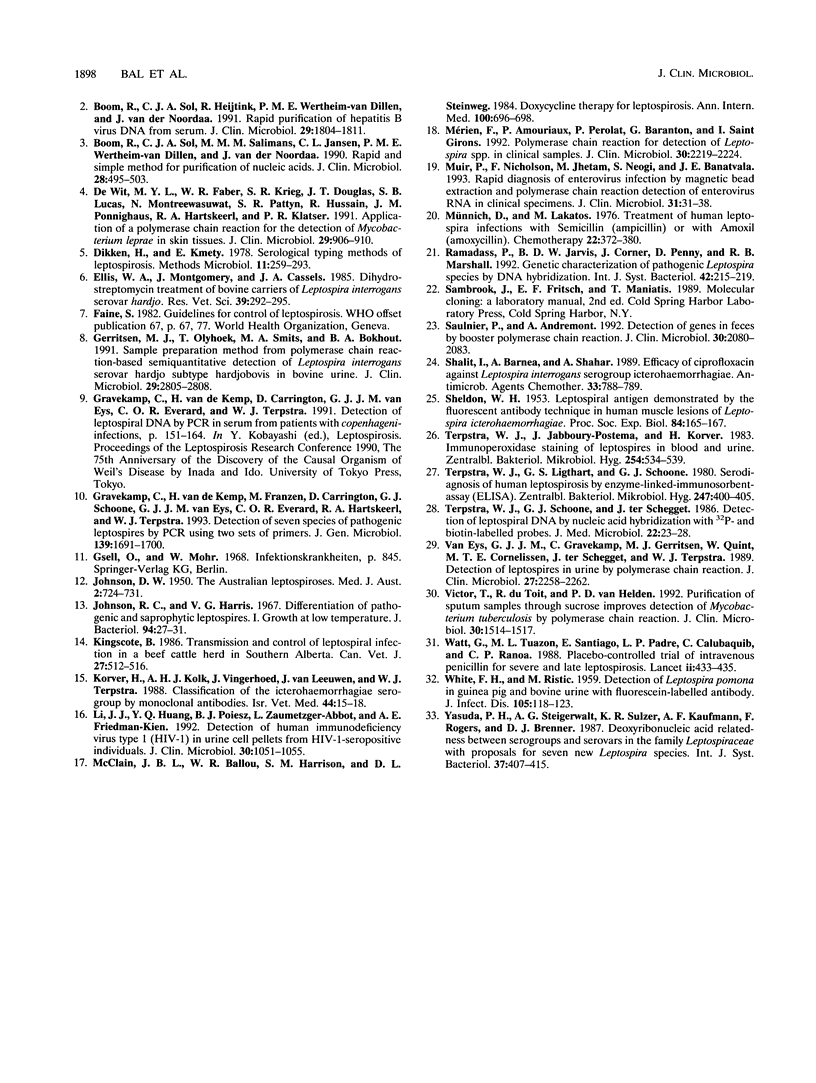
Images in this article
Selected References
These references are in PubMed. This may not be the complete list of references from this article.
- Alexander A. D., Rule P. L. Penicillins, cephalosporins, and tetracyclines in treatment of hamsters with fatal leptospirosis. Antimicrob Agents Chemother. 1986 Dec;30(6):835–839. doi: 10.1128/aac.30.6.835. [DOI] [PMC free article] [PubMed] [Google Scholar]
- Boom R., Sol C. J., Heijtink R., Wertheim-van Dillen P. M., van der Noordaa J. Rapid purification of hepatitis B virus DNA from serum. J Clin Microbiol. 1991 Sep;29(9):1804–1811. doi: 10.1128/jcm.29.9.1804-1811.1991. [DOI] [PMC free article] [PubMed] [Google Scholar]
- Boom R., Sol C. J., Salimans M. M., Jansen C. L., Wertheim-van Dillen P. M., van der Noordaa J. Rapid and simple method for purification of nucleic acids. J Clin Microbiol. 1990 Mar;28(3):495–503. doi: 10.1128/jcm.28.3.495-503.1990. [DOI] [PMC free article] [PubMed] [Google Scholar]
- Ellis W. A., Montgomery J., Cassells J. A. Dihydrostreptomycin treatment of bovine carriers of Leptospira interrogans serovar hardjo. Res Vet Sci. 1985 Nov;39(3):292–295. [PubMed] [Google Scholar]
- Gerritsen M. J., Olyhoek T., Smits M. A., Bokhout B. A. Sample preparation method for polymerase chain reaction-based semiquantitative detection of Leptospira interrogans serovar hardjo subtype hardjobovis in bovine urine. J Clin Microbiol. 1991 Dec;29(12):2805–2808. doi: 10.1128/jcm.29.12.2805-2808.1991. [DOI] [PMC free article] [PubMed] [Google Scholar]
- Gravekamp C., Van de Kemp H., Franzen M., Carrington D., Schoone G. J., Van Eys G. J., Everard C. O., Hartskeerl R. A., Terpstra W. J. Detection of seven species of pathogenic leptospires by PCR using two sets of primers. J Gen Microbiol. 1993 Aug;139(8):1691–1700. doi: 10.1099/00221287-139-8-1691. [DOI] [PubMed] [Google Scholar]
- JOHNSON D. W. The Australian leptospiroses. Med J Aust. 1950 Nov 11;2(20):724–731. doi: 10.5694/j.1326-5377.1950.tb106863.x. [DOI] [PubMed] [Google Scholar]
- Johnson R. C., Harris V. G. Differentiation of pathogenic and saprophytic letospires. I. Growth at low temperatures. J Bacteriol. 1967 Jul;94(1):27–31. doi: 10.1128/jb.94.1.27-31.1967. [DOI] [PMC free article] [PubMed] [Google Scholar]
- Kingscote B. Transmission and control of leptospiral infection in a beef cattle herd in southern alberta. Can Vet J. 1986 Dec;27(12):512–516. [PMC free article] [PubMed] [Google Scholar]
- Li J. J., Huang Y. Q., Poiesz B. J., Zaumetzger-Abbot L., Friedman-Kien A. E. Detection of human immunodeficiency virus type 1 (HIV-1) in urine cell pellets from HIV-1-seropositive individuals. J Clin Microbiol. 1992 May;30(5):1051–1055. doi: 10.1128/jcm.30.5.1051-1055.1992. [DOI] [PMC free article] [PubMed] [Google Scholar]
- McClain J. B., Ballou W. R., Harrison S. M., Steinweg D. L. Doxycycline therapy for leptospirosis. Ann Intern Med. 1984 May;100(5):696–698. doi: 10.7326/0003-4819-100-5-696. [DOI] [PubMed] [Google Scholar]
- Muir P., Nicholson F., Jhetam M., Neogi S., Banatvala J. E. Rapid diagnosis of enterovirus infection by magnetic bead extraction and polymerase chain reaction detection of enterovirus RNA in clinical specimens. J Clin Microbiol. 1993 Jan;31(1):31–38. doi: 10.1128/jcm.31.1.31-38.1993. [DOI] [PMC free article] [PubMed] [Google Scholar]
- Mérien F., Amouriaux P., Perolat P., Baranton G., Saint Girons I. Polymerase chain reaction for detection of Leptospira spp. in clinical samples. J Clin Microbiol. 1992 Sep;30(9):2219–2224. doi: 10.1128/jcm.30.9.2219-2224.1992. [DOI] [PMC free article] [PubMed] [Google Scholar]
- Münnich D., Lakatos M. Treatment of human leptospira infections with semicillin (ampicillin) or with amoxil (amoxycillin). Chemotherapy. 1976;22(6):372–380. doi: 10.1159/000221949. [DOI] [PubMed] [Google Scholar]
- Ramadass P., Jarvis B. D., Corner R. J., Penny D., Marshall R. B. Genetic characterization of pathogenic Leptospira species by DNA hybridization. Int J Syst Bacteriol. 1992 Apr;42(2):215–219. doi: 10.1099/00207713-42-2-215. [DOI] [PubMed] [Google Scholar]
- SHELDON W. H. Leptospiral antigen demonstrated by the fluorescent antibody technic in human muscle lesions of Leptospirosis icterohemorrhagiae. Proc Soc Exp Biol Med. 1953 Oct;84(1):165–167. doi: 10.3181/00379727-84-20578. [DOI] [PubMed] [Google Scholar]
- Saulnier P., Andremont A. Detection of genes in feces by booster polymerase chain reaction. J Clin Microbiol. 1992 Aug;30(8):2080–2083. doi: 10.1128/jcm.30.8.2080-2083.1992. [DOI] [PMC free article] [PubMed] [Google Scholar]
- Shalit I., Barnea A., Shahar A. Efficacy of ciprofloxacin against Leptospira interrogans serogroup icterohaemorrhagiae. Antimicrob Agents Chemother. 1989 May;33(5):788–789. doi: 10.1128/aac.33.5.788. [DOI] [PMC free article] [PubMed] [Google Scholar]
- Terpstra W. J., Jabboury-Postema J., Korver H. Immunoperoxidase staining of leptospires in blood and urine. Zentralbl Bakteriol Mikrobiol Hyg A. 1983 Jul;254(4):534–539. [PubMed] [Google Scholar]
- Terpstra W. J., Ligthart G. S., Schoone G. J. Serodiagnosis of human leptospirosis by enzyme-linked-immunosorrbent-assay (ELISA). Zentralbl Bakteriol A. 1980 Aug;247(3):400–405. [PubMed] [Google Scholar]
- Terpstra W. J., Schoone G. J., ter Schegget J. Detection of leptospiral DNA by nucleic acid hybridisation with 32P- and biotin-labelled probes. J Med Microbiol. 1986 Aug;22(1):23–28. doi: 10.1099/00222615-22-1-23. [DOI] [PubMed] [Google Scholar]
- Van Eys G. J., Gravekamp C., Gerritsen M. J., Quint W., Cornelissen M. T., Schegget J. T., Terpstra W. J. Detection of leptospires in urine by polymerase chain reaction. J Clin Microbiol. 1989 Oct;27(10):2258–2262. doi: 10.1128/jcm.27.10.2258-2262.1989. [DOI] [PMC free article] [PubMed] [Google Scholar]
- Victor T., du Toit R., van Helden P. D. Purification of sputum samples through sucrose improves detection of Mycobacterium tuberculosis by polymerase chain reaction. J Clin Microbiol. 1992 Jun;30(6):1514–1517. doi: 10.1128/jcm.30.6.1514-1517.1992. [DOI] [PMC free article] [PubMed] [Google Scholar]
- WHITE F. H., RISTIC M. Detection of Leptospira pomona in guinea pig and bovine urine with fluorescein-labeled antibody. J Infect Dis. 1959 Sep-Oct;105:118–123. doi: 10.1093/infdis/105.2.118. [DOI] [PubMed] [Google Scholar]
- Watt G., Padre L. P., Tuazon M. L., Calubaquib C., Santiago E., Ranoa C. P., Laughlin L. W. Placebo-controlled trial of intravenous penicillin for severe and late leptospirosis. Lancet. 1988 Feb 27;1(8583):433–435. doi: 10.1016/s0140-6736(88)91230-5. [DOI] [PubMed] [Google Scholar]
- de Wit M. Y., Faber W. R., Krieg S. R., Douglas J. T., Lucas S. B., Montreewasuwat N., Pattyn S. R., Hussain R., Ponnighaus J. M., Hartskeerl R. A. Application of a polymerase chain reaction for the detection of Mycobacterium leprae in skin tissues. J Clin Microbiol. 1991 May;29(5):906–910. doi: 10.1128/jcm.29.5.906-910.1991. [DOI] [PMC free article] [PubMed] [Google Scholar]




